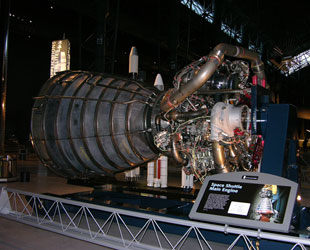December 17, 2008 — Museums interested in exhibiting NASA's space shuttle orbiters after they're retired in 2010 may need to meet certain requirements set by the space agency on Wednesday, including the ability to underwrite upwards of $40 million in shipping and handling charges.
The prerequisites, which were outlined in a formal request for information posted on NASA's website, seek to insure that the orbiters are properly displayed, that they are used to "inspire the American public and students in particular" and if possible do so without burdening NASA with having to pay for the vehicles' preparation and transfer.
The fee per shuttle, which NASA estimates today will run $42 million (but cautions that the estimates are subject to change) are not for the vehicle itself, but the work needed before it is suitable for exhibition.
"It is really not selling the orbiter, it is the preparation," said NASA spokesman Michael Curie in an interview with collectSPACE, explaining that $28.2 million goes toward "safing" the orbiter, "which is primarily, removing all the hypergolic fuel systems and other environmental hazards from the shuttle," $8 million for making it ready for display and $5.8 million for ferrying it on NASA's modified Boeing 747 to an airport near the museum.
The projected price tag does not include the provision of an indoor, climate-controlled facility to house the shuttle, which NASA requires. Nor does it come with the orbiter's three space shuttle main engines (SSMEs).

| A space shuttle main engine on display at the Smithsonian. |
According to the request for information, "NASA plans to initially retain flight-worthy SSMEs for technical mitigation and potential programmatic reuse. The Space Shuttle Orbiters that would be available for donation after the end of the program would be offered without flight SSMEs."
NASA can fabricate engine bay covers or mock nozzles for an additional price, offers the document, or museums may choose to request non-flight-worthy unassembled or partially assembled engines, which are estimated to cost between $400,000 and $800,000 per unit, exclusive of the shipping costs.
Curie didn't immediately know why the orbiters and their engines were being donated separately, but speculated it might be to simplify the delivery of the shuttles.
Though NASA has three orbiters -- Discovery, Atlantis and Endeavour -- only two will be available for donation. NASA plans to reserve the third for the Smithsonian's National Air and Space Museum, assuming they too can meet the same financial and facility requirements as the other museums.
"The National Air and Space Museum has been offered the space shuttle Discovery and has to pay the estimated $42 million," stated Curie.
The Smithsonian, which has an agreement with NASA to have first right of refusal on all space flown artifacts, and which previously took possession of all of the United States' crewed spacecraft including the flight test orbiter Enterprise, is not believed to have previously been made to pay the agency for their vehicles.
"We were in a different era then, where we had no eBay and people who were looking to make money off of artifacts," said Curie. "So it was to everyone's advantage to try to provide them to those who might display them."
Valerie Neal, space shuttle curator for the Air and Space Museum, told collectSPACE she was aware of the NASA request for information but was not prepared to comment.
Under their current schedule, NASA expects the orbiters would be available for donation no earlier than Sept. 30, 2011, one year after their final flight. The agency will hold the vehicles in storage at the Kennedy Space Center in Florida until the chosen recipients are ready, but desires to complete their delivery by no later than May 31, 2012.
Science museums, in addition to educational institutions and other appropriate organizations, are being asked to reply to NASA's
information request by March 17, 2009. The agency plans to use the data it gathers to judge the feasibility of their donation strategy, as well as perhaps identify specific organizations to receive the orbiters and engines.
